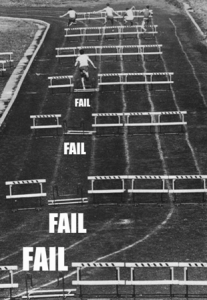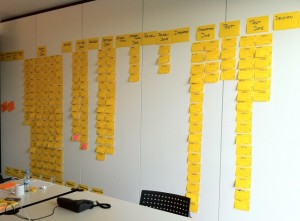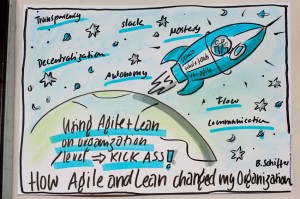Information needs to be presented to a learner in at least 6 different ways to stick in his mind. Repetition rules. On the other hand, an athlete repeats the same technique thousands of times in the same way to get it to stick in his mind. Repetition rules, again. Should you learn in different ways or in the same way? Continue reading
42 Tasks for a Scrum Master’s Job

Scrum Master is a full time job
(Tonight’s Moon – 20-01-2011 by Adam Wyles and
Crescent Moon by Luis Argerich)
Questions like the following are coming up quite often when I do Scrum training or coaching:
Why should the Scrum Master and Project Manager roles be filled different people? (Quora)
Will a scrum master for a team of 10 be a full time position or can a programmer fill this position if highly trained in agile planning? (Quora)
Behind those questions is the assumption that the Scrum Master is not a full time role. The askers of those questions conjecture that you save money by merging two roles or by placing the duty of the two roles on a single person. Continue reading
201 Tickets and Other Impressions when Building the First Kanban Board
One of the principles of Kanban is to visualize the work in progress. In an Agile pilot, often one of the first steps is to build a Kanban board. The amount of work visualized on the board is surprising in most cases. Here’s one example. Continue reading
Don’t Use Fake Due Dates in Kanban
At it-agile we use a Kanban board for acquisition. Once we turned all our tickets on our acquisition Kanban board into fixed delivery date tickets. We wanted to decrease our average lead time by reminding those who where working on the tickets to keep on working. Good intention, bad execution. Here’s why. Continue reading
Session “How Agile and Lean Changed My Organization” at Lean Kanban Central Europe
At Lean Kanban Central Europe conference 2011 in Munich, Germany I spoke about How Agile and Lean Changed My Organization. Here’s a short summary of this session. Continue reading
Kaizen and Kaikaku Regardless of Scrum and Kanban
Every now and then I hear the following being said when one compares Kanban and Scrum: Kanban is Kaizen, with continuous improvement and soft and smooth changes, and whereas Scrum is Kaikaku, with disruptiv improvement and hard and rough changes. I disagree, and I’d like to explain why. Continue reading
3 Metrics for Reporting an Agile Pilot to Top Management
During the introduction of Scrum in an enterprise, e.g. via an Agile pilot, the question of how to report to the upper or top management comes up. I’d suggest to use these three metrics as a starting point:
- customer feedback
- release burnup
- happy index
Here are the details and the reasons for my choice: Continue reading
How to Track the Team’s Mood with a Niko-niko Calendar
You can track a lot of stuff in Agile projects, like lead time, velocity, bugs and so on. Tracking those metrics helps the team to identify problems early and without them it’s harder to improve.
The faster you can get those numbers, the faster you can analyse them, look ahead and steer the project in a better direction. This is all about tightening the feedback loop. The faster you get feedback, the faster you can react.
Feelings are the fastest feedback I know. Continue reading
7 Steps to Build a Kanban Board for a Scrum Team’s Impediments
According to the Scrum Guide, “Daily Scrums … identify and remove impediments to development …“. They also advise that this is a service for the Development Team offered by the Scrum Master. Often an impediment backlog is used for this purpose. I’d advise the Scrum Master to use a Kanban board for handling the Development Team’s impediments. Continue reading
Imagination to Overcome Fears of Change
When I introduce Agile in a company, I’ll confront the employees with change. I’ll teach them to imagine the result of the outcome to overcome fears of change. This post with the story of Cliff Young is about what I tell them. Continue reading











